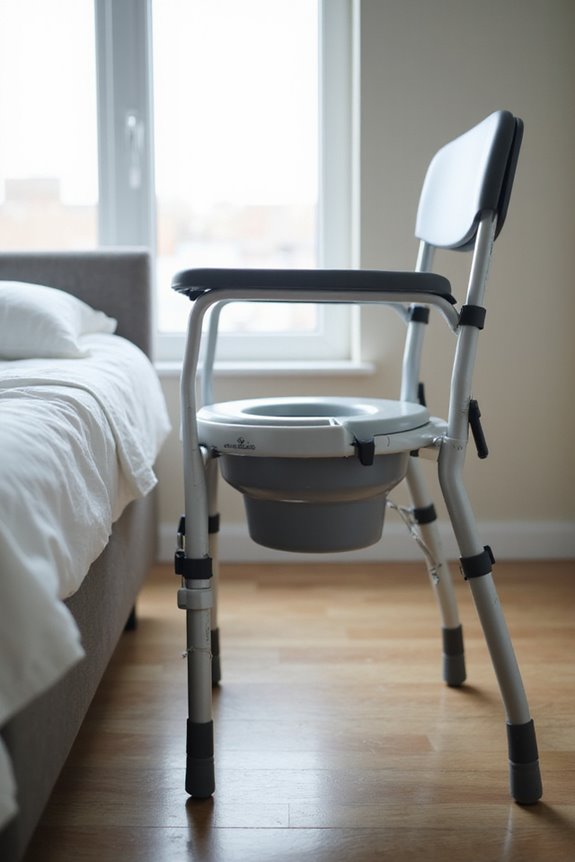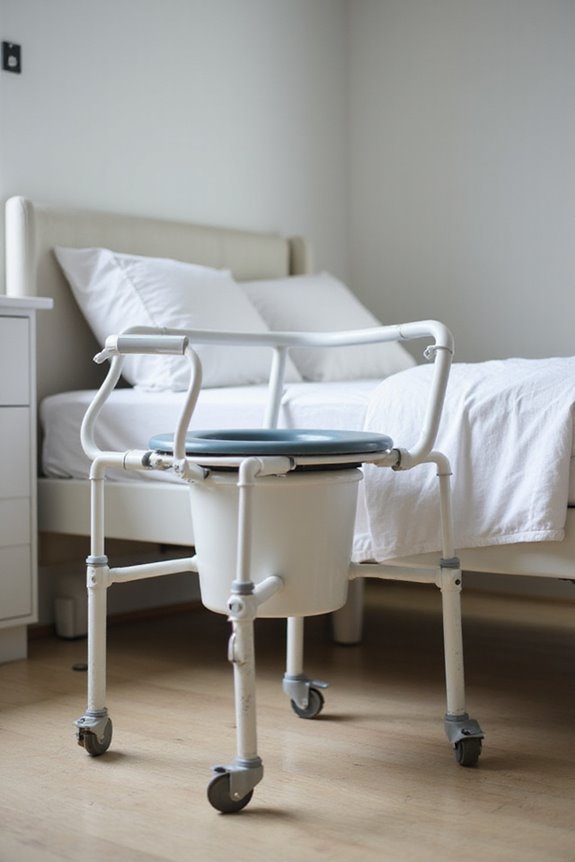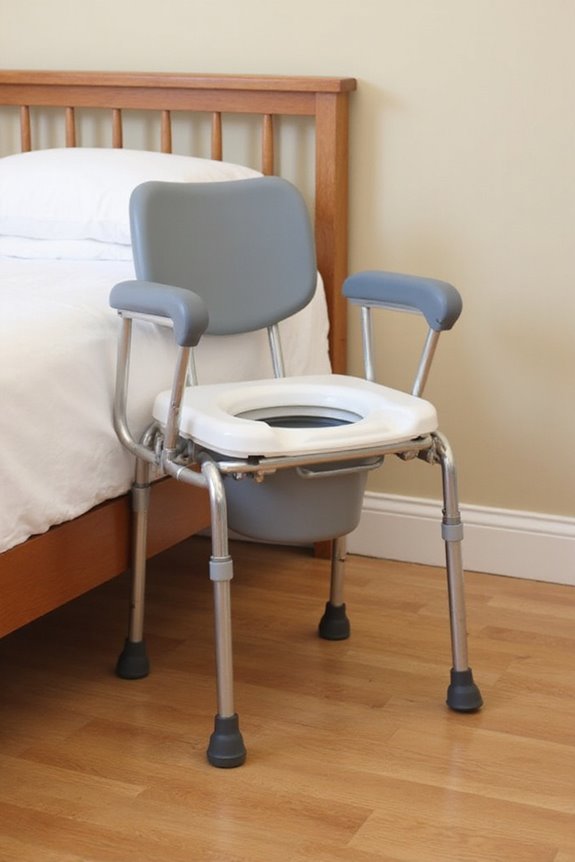To use a bedside commode chair, first, prepare the area by removing obstacles and ensuring good lighting. Position the commode within easy reach of the bed, adjusting its height for user comfort. For transferring, align the commode at a 45-degree angle to enhance safety. Secure all locking mechanisms and utilize nonslip footwear. After use, don disposable gloves and clean the bucket with warm water and disinfectants. Various types include 3-in-1 models and bariatric options for specific needs; further details follow.
Key Takeaways
- Ensure the commode is positioned on a stable, level surface and within easy reach of the bed for easy access.
- Adjust the height of the commode legs for user comfort and secure all locking mechanisms before use.
- Position the commode at a 45-degree angle to the bed for efficient transfers, ensuring it is stable and obstacle-free.
- Encourage the use of nonslip footwear and confirm the area is well-lit to enhance safety during transfers.
- After use, wear disposable gloves to clean the commode, disinfecting all surfaces and thoroughly washing hands afterward.
Preparing to Use a Bedside Commode
Preparing to use a bedside commode requires careful attention to the environment, guaranteeing safety and convenience for the user.
Environment Setup
- Clear the area of obstacles to prevent tripping hazards.
- Position the commode on a level surface for stability.
- Guarantee good lighting to facilitate safe movement.
User Comfort Considerations
- Place toilet paper and gloves within reach of the user.
- Adjust the height of the commode legs to enhance user comfort and mobility.
- Use nonslip mats or rugs to minimize slipping risks.
Stability Checks
- Lock commode wheels and verify stability.
- Confirm all legs are adjusted to equal heights for maximum support.
These steps contribute to a safe, accessible environment, promoting user comfort and mobility during use.
Positioning and Transferring Onto the Commode

Positioning a bedside commode chair effectively is critical for facilitating safe transfers for users.
- Place the commode within easy reach of the bed, particularly for nighttime use.
- Position it next to the bed with the wider side against the bed for enhanced transfer accessibility.
- Adjust the height of the bed slightly above the commode to utilize gravity during sliding transfers.
- Confirm the commode is stable on a level surface to prevent accidents.
- Align the commode at a 45-degree angle to the bed or wheelchair to improve movement efficiency.
For effective transfer techniques, users should slide onto the commode using upper body strength, confirming minimal gap between the commode and wheelchair or bed for safety. Additionally, ensure that the commode has non-slip handles to enhance grip stability during transfers.
Using the Commode Safely

Using a bedside commode safely is vital for minimizing the risk of accidents and guaranteeing user comfort.
Commode Stability
- Verify the stability of the commode by confirming all legs are tightened and of equal height.
- Check that locking mechanisms on adjustable legs are secured to prevent accidental collapse.
- If the commode has wheels, confirm they are locked before use.
Floor and Surrounding Area Safety
- Position the commode in a spacious, obstacle-free area for safe access.
- Ensure the floor is nonslip or covered with nonskid mats.
User Footwear and Mobility Support
- Encourage the use of nonslip footwear to prevent falls.
- Utilize armrests or grab bars for support during transfers.
Additionally, regular inspections for rust or damage are also vital for maintaining commode safety, similar to how transfer benches have stability features to enhance safety during use.
Regular inspections for rust or damage are also vital for maintaining commode safety.
Cleaning and Post-Use Procedures

Maintaining the cleanliness of a bedside commode is essential for guaranteeing hygiene and user safety. The following cleaning procedures should be strictly adhered to after each use:
- Emptying and Initial Waste Disposal: Always wear disposable gloves. Carefully lift the commode bucket, pour waste slowly into the toilet, and rinse the bucket with warm water.
- Cleaning the Commode Bucket: Use disinfectants safe for plastics. Wipe the inside thoroughly, avoiding toilet bowl cleaners. Allow to air dry.
- Cleaning the Frame, Seat, and Lid: Disinfect these parts weekly, focusing on contact points. Wipe with a damp cloth afterward.
- Post-Cleaning Hygiene: Dispose of gloves immediately, wash hands thoroughly, and inspect for any damage regularly.
Following these steps guarantees effective waste disposal and minimizes health risks.
Types and Features of Bedside Commodes

Bedside commodes are essential mobility aids that cater to various user needs, providing convenience and safety in home healthcare settings. Understanding commode types is vital for ensuring user comfort and functionality.
- 3-in-1 Commode Chairs: Versatile, serving as standalone toilets, raised seats, and safety frames.
- Bariatric Commodes: Support higher weight limits, typically 500 to 1,000 pounds, with reinforced materials for stability.
- Folding and Portable Commodes: Lightweight, ideal for travel or temporary use.
- Drop Arm Commodes: Armrests that fold down aid in user transfer.
- Stationary Commodes: Fixed in place, offering stability for long-term use.
Key features include adjustable heights for user comfort, padded seats, and discreet designs that blend with home decor, enhancing the overall user experience. Additionally, these commodes often come with safety features such as non-slip leg caps and wider bases to enhance stability and reduce the risk of tipping.
Safety Considerations and Best Practices
Safety considerations are paramount when utilizing a bedside commode chair, guaranteeing both user comfort and risk mitigation.
Commode Stability:
- Regularly inspect for stability and tighten all hardware.
- Guarantee leg heights are equal to prevent tipping.
- Lock wheels before use and discourage leaning back.
Preparation and Placement:
- Position within easy reach of the bed, free of clutter.
- Stock necessary supplies like gloves and toilet paper.
- Use nonslip footwear to minimize slip hazards.
Hygiene Protocols:
- Dispose of liners after each use and clean the commode thoroughly.
- Wear disposable gloves when handling waste and sanitizing.
Risk Management:
- Monitor for short sitting times and provide assistance during transfers.
- Maintain regular equipment checks to guarantee safety and functionality.
Frequently Asked Questions
How Do I Choose the Right Bedside Commode for My Needs?
Choosing the right bedside commode involves evaluating bedside commode features, including seat dimensions and adjustability, while prioritizing user comfort. A thoughtful selection guarantees dignity and ease for individuals seeking independence in their daily routines.
Can a Bedside Commode Be Used for Individuals With Mobility Issues?
A bedside commode is highly beneficial for individuals facing mobility challenges, providing essential commode accessibility. It enables safer, more independent toileting, enhancing dignity and comfort while reducing the risk of accidents during bathroom trips.
What Are the Common Materials Used in Bedside Commodes?
Many believe bedside commodes are solely metal or wood, yet common materials include plastic construction for lightweight options and metal frames like aluminum or stainless steel, blending durability with practicality for diverse needs and environments.
Are There Any Privacy Considerations While Using a Bedside Commode?
Privacy concerns are essential when using a bedside commode, as they directly impact user comfort. Implementing screens, positioning strategically, and utilizing privacy curtains can create a more secure and comfortable environment for individuals during use.
How Often Should a Bedside Commode Be Replaced?
Replacement signs, such as instability or wear, signal when to replace a bedside commode. The commode lifespan typically spans five years, yet users must assess individual needs and conditions to guarantee safety and comfort continually.





